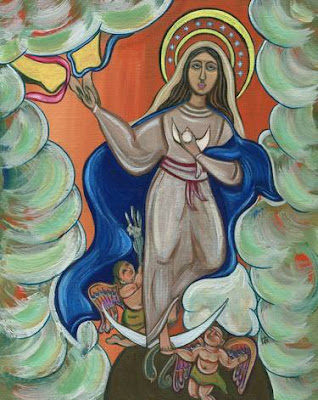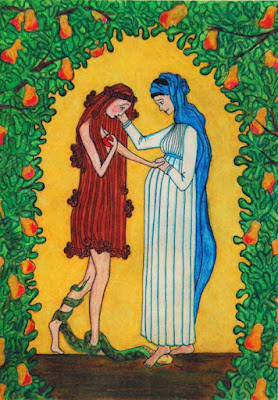FROM MARY TO US, A CHALLENGE TO BE SINLESS.
December 9 2019: Solemnity of the Immaculate Conception of the Blessed Virgin Mary
A Japanese proverb says, “A faultless person has seven
faults, a faulty person forty-eight faults.”
Starting from this Pauline statement, “all have sinned and
are deprived of the glory of God” (Romans 3:23) taken out of context, the
Catholic dogma of the Immaculate Conception would suffer all the accusations
and criticisms. But, happily, further, Paul adds, “They are justified freely by
his grace through the redemption in Christ Jesus.”
What do we actually profess, through this celebration? A
simple reality, that God, wanting to save human beings from the sin that keeps
them in slavery and away from Him, chose to be incarnated through a woman and
become one of us. But in order for this mystery of salvation to be realized, he
has in advance preserved the who would become his mother from the defilement of
sin.
The Immaculate Conception of the Blessed Virgin Mary is the
most beautiful fruit of the work of redemption accomplished by her Divine Son
Jesus Christ. Chosen to be the Mother of the Savior, God did not allow sin to
corrupt her body. Mary, therefore, became the first model of holiness for all Christians.
Beforehand, she beneficiated from the fruit of the Lord passion.
Beyond the dogmatic statement, the Immaculate Conception of
Mary, though not biblically founded, is not just a work of imagination or other
trickery of Catholics. It can be clearly understood if we consider it as part
of the overall plan of salvation. Indeed, the humanity of Christ is linked to
the humanity of Mary by the singular role that was entrusted to her in the
mystery of the incarnation. In Adam and Eve, mankind has disobeyed God and
fallen into the decay of sin. From there, we all became sinners (Romans 3:23).
God, however, wanted to free us from this disobedience. So, did he choose to
become one of us.
But, coming to free man from sin, he could not be born in
sin himself. Therefore, he has prepared a dwelling without stain, the womb of
Mary. What we proclaim here is that Mary was released from the corruption of
sin from the first moment of her life to serve the purpose of God. She was in a
state of sanctification by the grace of God from the moment of her conception.
This is the Dogma that Pope Blessed Pius IX declared in his
Apostolic Constitution, “Ineffabilis Deus” – God Ineffable, stated: “We
declare, pronounce, and define that the doctrine which holds that the most
Blessed Virgin Mary, in the first instance of her conception, by a singular
grace and privilege granted by Almighty God, in view of the merits of Jesus
Christ, the Savior of the human race, was preserved free from all stain of
original sin, is a doctrine revealed by God and therefore to be believed firmly
and constantly by all the faithful.” And this Dogma will be attested by a
special seal with the apparition of the Blessed Virgin to the young shepherdess
of Lourdes, Bernadette, saying to her, “I am the Immaculate Conception.”
From Mary to us, the message of the solemnity of the
Immaculate Conception is quite simple: the unveiling of the mystery of
salvation and the universal call to holiness. Mary is immaculate by conception.
We are called to be immaculate by adoption and renunciation of sin. The
Immaculate Conception is above all a Christocentric Dogma and an integral part
of soteriology.
Indeed, Mary is declared by the work of God and the Holy
Spirit, without sin by birth. She is the symbol, the sign of human's victory
over sin and the ancient serpent. Mary, we will never say it enough, is one of
us, a simple creature like you and me. She is not divine nor angelic. All that
she is and all we sing about her are the fruits of what God has done with her
and through her. In today's excerpt from St. Luke, it is clearly said that she
was privileged by God, a favored one, chosen among all women to become the
Mother of God (Luke 1:30). Mary could have said no to this divine project. But
because she was predestined, prepared in advance by God himself, her response
to his will was the most instantaneous: “Behold, I am the handmaid of the Lord.
May it be done to me according to your word.”
Imagine a scenario where God would not have predestined Mary
to that purpose. As St. Luke mentioned, Mary was betrothed to a man named
Joseph. She was also very familiar with the Judaic law on marriage; and not
only that, she also had her personal life project. Making use of her freedom
and human reason or philosophy, she could have said, “No, I cannot because I am
already promised to a man and the law does not allow me to do anything other
than being his wife at the cost of my life and the honor of my family.” But nothing
of this, her answer was: "Fiat voluntas tua" (Your will be done).
By Mary’s “YES” to the will of God, what was the original mankind
disobedience that led to the curse and its consequences (Genesis 3:16-17) is
repaired and paid for. The implications of this 'Fiat' is what Paul expresses in
second reading. In Christ, Son of Mary, God chose us before the foundation of
the world, to be holy and without blemish before him.” By adoption, we are made
immaculate, purified of all sins.
Our being immaculate by adoption is manifested in the obligation
to strive to avoid sin. God wants us holy. That is why he sent his Son to be
born of Mary. We must on our side contribute to that holiness by cutting all links
with the evil. It is obvious that we are all born sinners. But we are not
condemned to die sinners, unless we decide so. Mankind is not doomed to a sad end.
In many cases, the experiences of life show that we sin by choice. Sin is
something which involves a personal responsibility. Therefore, holiness becomes
also a choice to search for God’s will. The becoming immaculate by adoption is
a “Fiat” of mankind to the will of God and a refusal to fall in the seductions
of the world.
Taking some concrete cases, no one sins without a consent. All
sins are fact of our choices. Either freely or under constraint, they involve
our responsibility. For example, one who chooses willingly to drink and to
become a drunkard; one chooses to involve in pornography or prostitution; one
chooses to live in fornication or adultery; one chooses to not obey to his
parents or to violate the rules and ordinances and basic social norms… All are
matter of what I want to do or which temptation I choose to fall in.
Having Christ in us, we are urged to make the
right decision, to live as new creatures, freed from sin and blameless before
God by adoption. Like Mary, we are called to live in enmity with sin and say
yes to God’s will.





Comments
Post a Comment